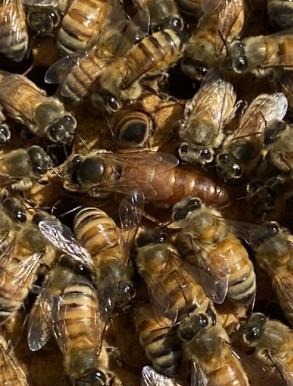Funded by a $1.1 million grant from the U.S. Department of Agriculture’s Foreign Agricultural Service, the team is partnering with beekeepers to build a predictive model and decision aid system that helps manage and protect pollinators.
“We need better tools to reduce colony losses,” said Rae Olsson, co-lead investigator and postdoctoral researcher with WSU’s Department of Entomology. “Our project helps beekeepers plan and place their colonies for improved health and sustainability.”
Four threats to colony health
Pollination is vital to most fruit and seed crops, but the pollinators themselves face a tenuous existence: one recent study found 43% of managed bee colonies died from 2019 to 2020.
“Honey bee colony loss is commonly attributed to what we call the ‘Four Ps’: pesticide exposure, poor nutrition, parasites, and pathogens,” Olsson said.
On the move themselves, beekeepers often have a hard time tracking the location, health, and treatment of each colony. This can lead to overuse of chemicals and the buildup of pesticides.

Rae Olsson, post-doctoral researcher at WSU’s Department of Entomology, co-leads research into honey bee health and survival.
“Once a beekeeper puts colonies in an orchard for pollination, bees are really at the mercy of the farm’s practices, and those of neighboring farmers,” Olsson said. “If a nearby farmer sprays a pesticide that is harmful to bees, and wind blows residues toward the crop where bees are located, the bees could be harmed or killed.”
Chemicals aren’t the only threat. If weather is exceptionally rainy or cold, flowers won’t bloom, meaning less food for bees.
“Beekeepers are often dealing with one or more of these factors, and some of the additive effects are unknown,” Olsson said.
To understand the relationship between location, environment, threats, and survival, WSU scientists want to create a standardized metric of colony health.
Partnering with Washington state beekeepers and a private technology company called Nectar, the team will follow colonies throughout their pollination journey over three years, testing and ground-truthing pesticide exposures and the availability of food sources across the landscape.
Scientists have begun checking hives and collecting monthly data on environmental and colony health, including the health of the queen, number of bees, food levels, and disease symptoms. They are also sampling pollen stores for pesticide residues.
New tools for beekeepers

A close-up of a queen and honey bees in an opened hive. Scientists will use personal inspections and technology to measure colony health.
Data will be used to create an overall score called Colony Health in Place and Season, or CHIPS, which will be used to develop a system that can predict and model colony health and survival. The system could tell a beekeeper if a given site and season will offer enough resources to sustain their bees.
“With colonies being constantly moved to new locations, there are many difficult-to-follow factors going back through the lifetime of the hive that may contribute to colony death,” Olsson said.
“Our technology could make things easier by allowing researchers to monitor thousands of hives remotely, and let beekeepers track their colonies in a streamlined way,” they added. “We’ll have a better understanding of how to keep hives healthy throughout the season.”
Additional partners in the research team include scientists at the WSU Northwestern Washington Research and Extension Center at Mount Vernon, Portland-based Synergistic Pesticide Laboratory, and WSU’s Decision Aid System.
Source : wsu.edu